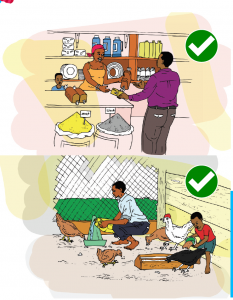
Parents should provide support to the other spouse until both become self-sufficient and independent
Spousal maintenance are agreements where one of the parties provide financial support. Agreements that provide financial support for a limited time until both sides are able to support themselves are recommended. This type of maintenance is known as non-permanent and it can help both parents to become more empowered. Permanent spousal maintenance is where the agreement is to continue providing financial support indefinitely, which can cause dependency.
Becoming self-sufficient and financially independent of the former spouse is important, as long as it does not negatively affect the children.
What practitioners say
Consistent with literature search:
Quantify income levels. Make sure to create an inventory of the declared income levels, assets and contributions of the man and woman in order to be able to reach fair agreements.
Consider non-monetary contributions. For calculating spousal maintenance, consider non-monetary as well as monetary contributions.
Involve a neutral third party. A neutral practitioner can help to assess the income support level that is needed.
Parties should help each other financially. The party with better financial standing should support the other – taking the interest of the child into consideration.
Other suggested practices:
Involve others who know the situation. Involve extended family, local leaders or other appropriate community members to provide insight.
Local leaders can help enforce agreements. Local leaders such as religious leaders and elders can help to enforce agreements, especially if there’s a breach.
Resources and Methodology
- Non-permanent spousal maintenance:
- Rehabilitative spousal maintenance
- Limited duration spousal maintenance
- Permanent spousal maintenance
- Jean van Houtte and Corinne de Vocht, The Obligation to Provide Maintenance between Divorced Husband and Wife in Belgium (1982)
- Cynthia L. Greene, Alimony is Not Forever (1988)
- Constance. L. Shehan, Alimony: An Anomaly in Family Social Science (2002)
- Twila B. Larkin, Guidelines for Alimony: The New Mexico Experiment (2004)
- Where the recipient abandoned her job and career to fulfill the expected, traditional roles of a mother, wife and hostess… (as cited in Greene, p. 13)
- Where there are minor children under the age of five and it is not practical for the recipient to generate income in excess of work-related child-care costs, or both parties are committed to one parent remaining home with the child(ren) (Larkin, p. 53).

Parents should make agreements on child support and, for the best interest of the child, support the other parent where needed
Both parents are responsible for costs of upbringing the child such as school fees, food, clothing and other expenses. It is important for parents to agree on child support. Parents should also be willing to support their children outside these agreements. Occasionally, children might need more food, clothing or other items than expected. Research shows that providing formal and informal child support benefits the wellbeing of children. Formal child support includes mutually agreed arrangements on financial contributions towards the costs of children. Informal child support may include other things from providing food, shelter, clothing, emotional support etc.
Legal base
Uganda Constitution, Article 32 Clause 4 Both parents are responsible for the upbringing of children and the costs related to this.
What practitioners say
Consistent with literature research:
Consider all options. Non-monetary contributions should be considered, not just financial agreements. These may include spending time with house chores, support with homework, moral upbringing or other forms of support for children.
Both parents should be involved in the moral education of children. Both parents each play an important role in children’s development, even after separation or re-marriage.
Parents should together decide and agree on the school for the child. Parents should take the best interests of the child into account together and make a joint decision on the best schooling arrangement.
Both parents should contribute to upbringing of children. Besides contributing to educational and other financial costs, the moral support and education of children should continue from both parents.
Other suggested practices:
Children might need a guardian. There may be cases where a parent is not in the picture. A guardian could be responsible for the upbringing arrangements for children
Resources and Methodology
- Formal and informal child support provided by non-residential parent
- Only formal child support provided by non-residential parent.
- No child support Formal child support payments are received through a welfare office (Greene and Moore, p. 159).
- Maureen R. Waller & Robert Plotnick, Effective Child Support Policy for Low-Income Families: Evidence from Street Level Research (2001)
- Paul R. Amato & Joan G. Gilbert, Nonresident Fathers and Children’s Well-being: A Meta-Analysis (1999)
- Lenna Nepomnyaschy, Child Support and Father-Child Contact: Testing Reciprocal Pathways (2007)
- Angela Greene & Kristin Moore, Nonresident Father Involvement and Child Well-Being Among Young Children in Families on Welfare (2000)
- Steven Garasky et al, Toward a Fuller Understanding of Nonresident Father Involvement: An Examination of Child Support, In-Kind Support, and Visitation (2009)

Both parents should secure independent and sustainable income
Both parents are responsible for taking care of their children. This requires financial support for things like school fees, clothing, food, shelter etc. After separation, people’s financial situation changes. They might struggle to generate enough income. It is therefore recommended that both sides should generate income by starting a small side business or to seek better employment opportunities. The goal is to provide a stable situation for the whole family.
Legal base
Uganda Constitution, Article 32 Clause 4
What practitioners say
Consistent with literature search:
Both parties should contribute financially. Both parents should contribute financially to the family. This can build a sense of responsibility and ownership.
Try to generate new sources of income. People can start a business.
Support each other. Both parents may struggle at times with their work or businesses. They should feel responsible for each other and their children’s well being.
Make sure agreements benefit the whole family. Parents should be encouraged to agree on the family business or other sources of income in ways that benefit the entire family.
Specify sources of income – such as livestock, vegetable and fruit businesses, retail shops etc.
Other suggested practices:
Manage finances together. Both parents should be involved in the planning, budgeting, management and evaluation of finances during the marriage.
Set up a family fund. Families should set up funds that they manage together. They should take a planned and strategic approach to manage housing, education etc.
Save and invest. Create a culture of saving and investing in the family and have a shared responsibility.
Create women support groups. Groups that focus on helping rural women to generate side income can help families to have more stable finances
Resources and Methodology
During the orientation process of the available literature, we were able to identify the following interventions:
Active measures [with the goal to generate more income]- Generate more working hours
- Self-employment
- Migration to areas with better employment opportunities
Other [passive] measures
- Applying for and receiving public assistance
- Remarrying
- Cutting back on expenditures
Financial resources are an important factor in the adaptations families make. Families save up in good times, and spend savings or borrow in bad. Families who do not have such savings, will not be able to do this (Yuen & Hofferth, p. 7). The analysis done by Yuen and Hofferth distinguishes between active measures (e.g. migration and increasing partner’s work effort) and other measures (e.g. relying on public assistance) (Yuen & Hofferth, p. 7 and 25). Families with substantial income and assets and those who live in low unemployment areas tend to take active measures, whereas families with little resources or in high unemployment areas are likely to rely on public assistance, remarriage or cutting back on expenditures (Yuen & Hofferth, p. 25). For purpose of the PICO question, we compare active (which generate more income) and passive measures, as the available literature makes, a distinction between these two strategies in overcoming post-divorce financial distress
The main sources used for this particular subject are:
- Wei-Jun Jean Yueng and Sandra L. Hofferth, Family Adaptations to Income and Job Loss in the U.S. (1998)
- Linda Scott, Catherine Dolan, Mary Johnstone-Lous, Kimberly Sugden, Maryalice Wu, Enterprise and Inequality: A Study of Avon in South Africa (2012)
- Caroline Dewilde and Wilfred Uunk, Remarriage as a Way to Overcome the Financial Consequences of Divorce- A Test of the Economic Need
- Hypothesis for European Women (2008)
- Naila Kabeer, Gender equality and women’s empowerment: A critical analysis of the third millennium development goal 1 (2005)
These sources are largely based on empirical studies. Evidence can be regarded as being low.
Desirable outcomes
One of the indicators to measure gender equality and women’s empowerment is the increase of women’s share of wage employment (Kabeer, p. 1). Paid work has the potential to shift the balance of power within the family. It also leads to a long-term reduction in domestic violence, as well as an increase in women’s assets (Kabeer, p. 18). In some cases, women’s participation in wage employment has allowed them to have greater economic independence and even to escape abusive marriages (Kabeer, p. 19).
Geographic migration has been viewed as a means of improving the allocation of human resources (Yueng & Hofferth, p. 5-6).
Undesirable outcomes
Seeking public assistance is stigmatizing and is seen as only a short term-option (Yueng & Hofferth, p. 24).
When it comes to cutting back on expenditures, cutting food expenditures points to the possibility of deteriorating living conditions that may threaten the survival of family members. (Yueng & Hofferth, p. 24).
Operating within a social setting unfriendly to women will be challenging due to, for example, pervasive violence. Women might encounter difficulties in running a door-to-door business in a country where no one opens the door out of fear. Moreover, women moving about to make sales, deliver products and meet teams are easy targets for such predators (Scott. et al., p. 562).
Migration to an area of better employment opportunities may weaken the family’s support network and detract from children’s school progress (Yueng & Hofferth, p. 24).
Balance of outcomes
In determining whether taking active measures with the goal of generating more income is more effective than taking passive measures, for the financial well-being of persons, the desirable and undesirable outcomes of both interventions must be considered.
An analysis of the outcomes shows a lack of consensus regarding which measure works. Research shows difficulties with using these strategies particularly due to national contexts. A suitable option is arguably exploring active measures because of efforts by divorced spouses to become self-supporting and self-sufficient.
Recommendation
Taking into account the balance towards the desired outcomes and the strength of the evidence, we make the following recommendation: Taking active measures to generate more income is more effective than taking passive measures for the well-being of families
0 Comments